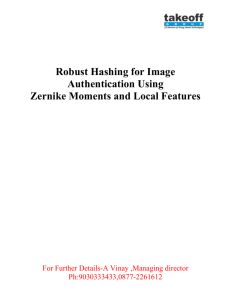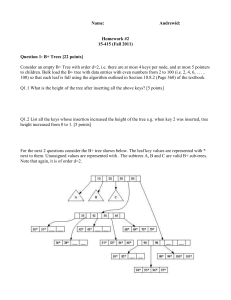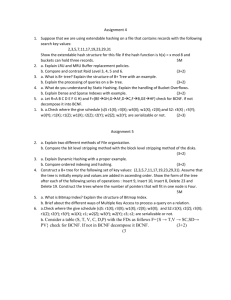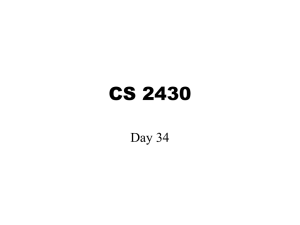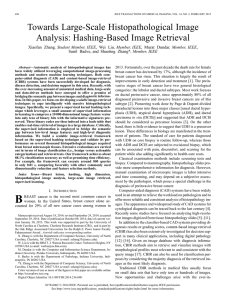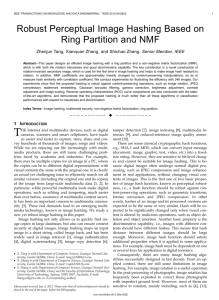Robust Hashing for Image Authentication Using Zernike Moments
advertisement
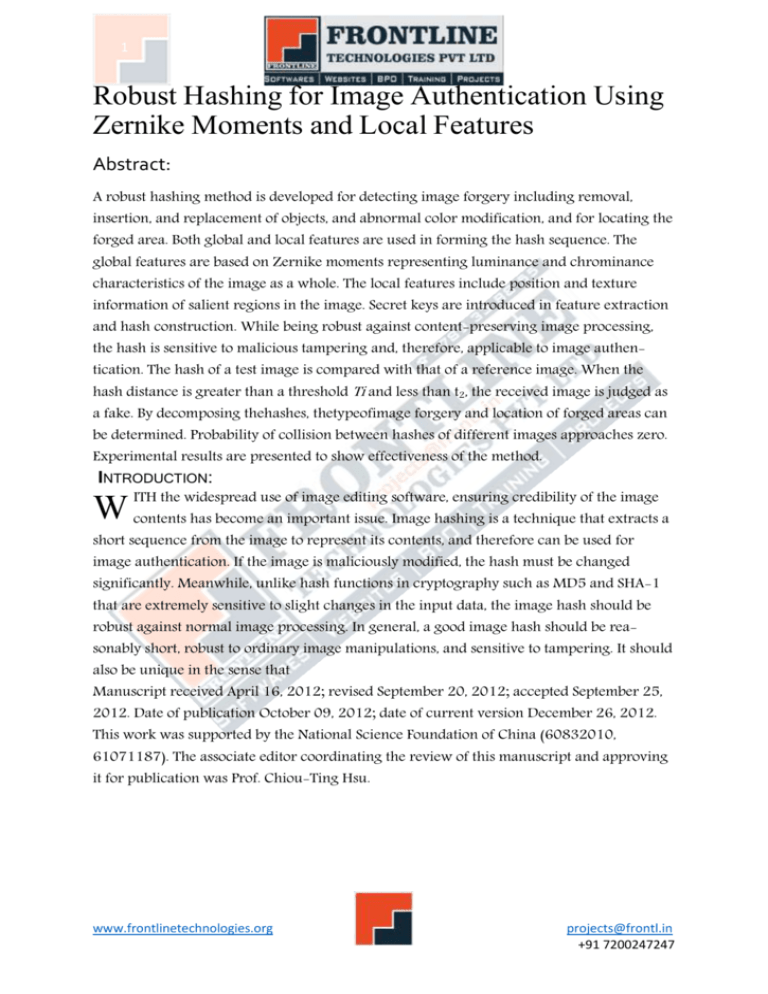
1 Robust Hashing for Image Authentication Using Zernike Moments and Local Features Abstract: A robust hashing method is developed for detecting image forgery including removal, insertion, and replacement of objects, and abnormal color modification, and for locating the forged area. Both global and local features are used in forming the hash sequence. The global features are based on Zernike moments representing luminance and chrominance characteristics of the image as a whole. The local features include position and texture information of salient regions in the image. Secret keys are introduced in feature extraction and hash construction. While being robust against content-preserving image processing, the hash is sensitive to malicious tampering and, therefore, applicable to image authentication. The hash of a test image is compared with that of a reference image. When the hash distance is greater than a threshold Ti and less than t2, the received image is judged as a fake. By decomposing thehashes, thetypeofimage forgery and location of forged areas can be determined. Probability of collision between hashes of different images approaches zero. Experimental results are presented to show effectiveness of the method. INTRODUCTION: the widespread use of image editing software, ensuring credibility of the image W ITH contents has become an important issue. Image hashing is a technique that extracts a short sequence from the image to represent its contents, and therefore can be used for image authentication. If the image is maliciously modified, the hash must be changed significantly. Meanwhile, unlike hash functions in cryptography such as MD5 and SHA-1 that are extremely sensitive to slight changes in the input data, the image hash should be robust against normal image processing. In general, a good image hash should be rea- sonably short, robust to ordinary image manipulations, and sensitive to tampering. It should also be unique in the sense that Manuscript received April 16, 2012; revised September 20, 2012; accepted September 25, 2012. Date of publication October 09, 2012; date of current version December 26, 2012. This work was supported by the National Science Foundation of China (60832010, 61071187). The associate editor coordinating the review of this manuscript and approving it for publication was Prof. Chiou-Ting Hsu. www.frontlinetechnologies.org projects@frontl.in +91 7200247247 2 Architecture Diagram: CONCLUSION: In this paper, an image hashing method is developed using both global and local features. The global features are based on Zernike moments representing the luminance and chrominance characteristics of the image as a whole. The local features include position and texture information of salient regions in the image. Hashes produced with the proposed method are robust against common image processing operations including brightness adjustment, scaling, small angle rotation, JPEG coding and noise contamination. Collision probability between hashes of different images is very low. The proposed scheme has a reasonably short hash length and good ROC performance. References: 1. V. Monga, A. Banerjee, andB. L. Evans, “A clustering based approach to perceptual image hashing,” IEEE Trans. Inf. Forensics Security, vol. 1, no. 1, pp. 68-79, Mar. 2006. 2. S. Xiang, H. J. Kim, and J. Huang, “Histogram-based image hashing scheme robust against geometric deformations,” in Proc. ACM Multimedia and Security Workshop, New York, 2007, pp. 121-128. 3. Z. Tang, S. Wang, X. Zhang, W. Wei, and S. Su, “Robust image hashing for tamper detection using non-negative matrix factorization,” J. Ubiquitous Convergence Technol., vol. 2, no. 1, pp. 18-26, May 2008. 4. A. Swaminathan, Y. Mao, and M. Wu, “Robust and secure image hashing,” IEEE Trans. Inf. Forensics Security, vol. 1, no. 2, pp. 215-230, Jun. 2006. 5. Y. Lei, Y. Wang, andJ. Huang, “Robust imagehashin Radon transform domain for authentication,” SignalProcess.: Image Commun., vol. 26, no. 6, pp. 280-288, 2011. 6. F. Khelifi and J. Jiang, “Perceptual image hashing based on virtual watermark detection,” IEEE Trans. Image Process., vol. 19, no. 4, pp. 981-994, Apr. 2010. www.frontlinetechnologies.org projects@frontl.in +91 7200247247 3 7. V. Monga and M. K. Mihcak, “Robust and secure image hashing via non-negative matrix factorizations,” IEEE Trans. Inf. Forensics Security, vol. 2, no. 3, pp. 376-390, Sep. 2007. 8. K. Fouad and J. Jianmin, “Analysis ofthe security ofperceptual image hashing based on non-negative matrix factorization,” IEEE Signal Process. Lett., vol. 17, no. 1, pp. 43^6, Jan. 2010. 9. Z. Tang, S. Wang, X. Zhang, W. Wei, and Y. Zhao, “Lexicographical framework for image hashing with implementation based on DCT andNMF,” Multimedia Tools Applicat., vol. 52, no. 2-3, pp. 325-345, 2011. 10. F. Ahmed, M. Y. Siyal, and V. U. Abbas, “A secure and robust hash- based scheme for image authentication,” Signal Process., vol. 90, no. 5, pp. 1456-1470, 2010. www.frontlinetechnologies.org projects@frontl.in +91 7200247247
